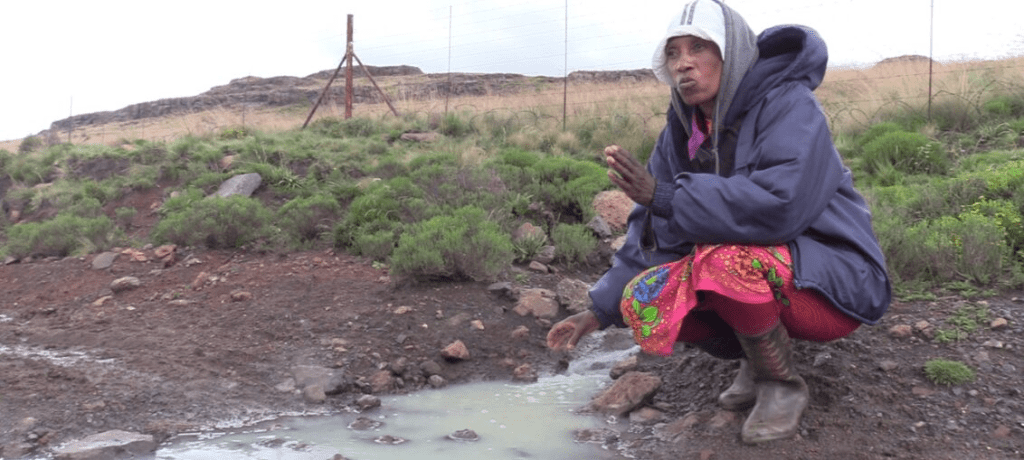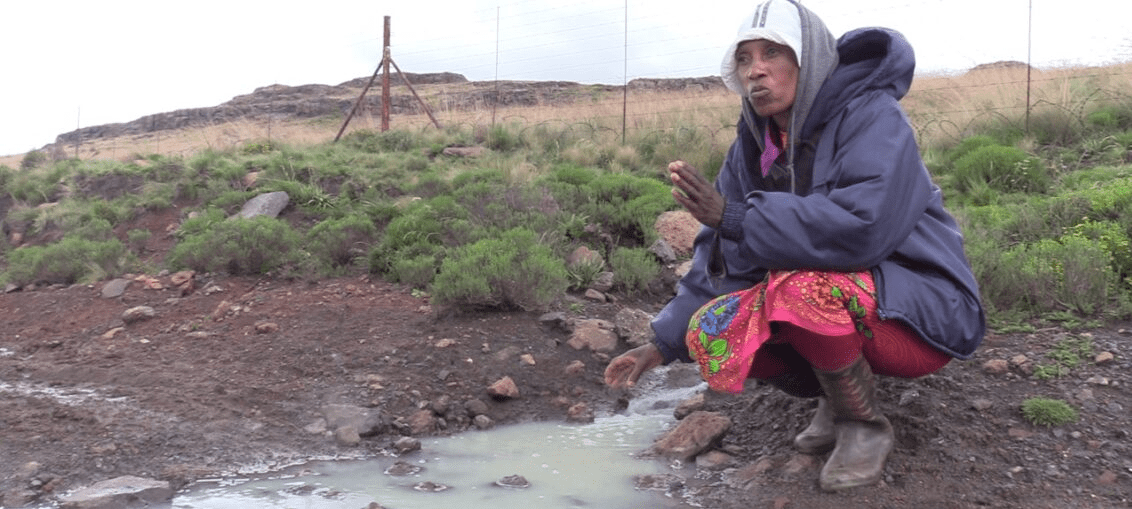Communities Blame Letšeng Mine Pollution For Trail Of Sickness, Death And ‘Poisoned Pasture’
17 May 2022 by Pascalinah Kabi
Bertha Foundation Fellow

‘Mapontso Lematla explains the real time Letšeng Diamonds Mine pollution captured on camera in March 2023. Credit: Retselisitsoe Khabo
Sitting in her modest hut in the rural enclave of Patising in Mokhotlong, Lesotho, the 52-year-old ‘Mapontso Lematla says she first spotted the discoloured water in the local stream decades ago.
“This water causes stomachaches and diarrhoea,” the soft-spoken Lematla said in an exclusive interview with MNN Centre for Investigative Journalism.
Many residents in the Patising and Maloraneng communities, who live downstream from Letšeng Diamonds Mine and rely on surrounding natural water sources for drinking and other household chores, tell stories of the blue and black water and believe this pollution is the cause of illness and death.
Lematla describes how the Patising stream sometimes overflows with mine tailings (‘motoro in local language).
World Health Organisation (WHO) says: “contaminated water and poor sanitation are linked to transmission of diseases such as diarrhoea….”.
‘The water is making us sick’
Clad in her purple blouse, dark sweater and white sunhat, Lematla says her Patising community is always battling diseases such as diarrhoea. She has lost count of how many times she’s fallen ill from drinking the contaminated water.
“I am one person who has serious difficulties using this water, it upsets my system,” says Lematla had diarrhoea and severe stomachache for two weeks between January and February this year.
“I had diarrhoea for whole two weeks, constantly running to the toilet. We have discussed water contamination issues with Letšeng many times”, adds Lematla, who also explains that some residents living in the older residential side of Patising, Ka Lithakong, depend on the stream for daily water needs.
While the Letšeng Diamonds Mine has constructed a borehole in the new village, for Lematla this is a ten-minute walk away.
She says accessing the borehole Letšeng constructed for Patising is not always easy for those staying at Ka Lithakong due to distance and sometimes, overflowing stream.
Scared of being swept by the sometimes overflowing stream or running out of water at awkward times forces her and others to use the stream for drinking water.
Sephapo Moletsane is a 72-year-old ex-miner-turned-unionist. Moletsane worked at Letšeng mine when it was owned by De Beers, a mining company that was asked by the Lesotho government to re-evaluate the Letšeng kimberlites in December 1976. It was later granted an eight-year mining lease.
“The contaminated water causes diarrhoea, a rash that I don’t know what name I can give to but there is that rash which forces people to scratch themselves, particularly small children. It also causes something similar to flu, people cough a lot, causing us to think that maybe they have tuberculosis,” Moletsane said.
In March this year, a Maloraneng father, Reboneng Matubatuba, blamed the death of his 13-year-old son on the mine.
Matubatuba says his son, who was crippled shortly after his fifth birthday, succumbed to diarrhoea and sharp stomachache after inhaling polluted air coming from a Letšeng blasting operation.
Matubatuba’s son inhaled the “odour from the smoke coming from Letšeng”. The next day, the deceased had diarrhoea that lasted for a month, leading to his death.
“A dark emission came towards the village and an odour was smelled all over the place. He complained about the odour. The following day, he woke up with diarrhoea.
“We thought this was the result of the smoke and the water since we drew it from the stream. The water was blue and salty. We didn’t have any access to clean water and depended on the stream water. I thought the smoke and the air were a cause of his sickness – the diarrhoea that went on until he died.
“He complained of a severe stomachache before he died. The suspicion is that the cause of his death is the smoke and the water from the stream,” Matubatuba said.
A postmortem was not done as this is expensive and not something that is an option for poverty-stricken Patising and Maloraneng communities.
In a statement to MNN, Letšeng Diamonds Mine chief executive officer, Kelebone Leisanyane said: “Any suggestion of the company’s activities having adverse impacts on the health of the community members is baseless”.
Maluti Community Development Forum (MCDF), an interest group that defends the rights of the poor communities in Lesotho’s mining areas, claims there have been at least two death incidents suspected to be associated with the water contamination in Patising and Maloraneng villages.
“One of those incidents, in Maloraneng, concerns a one-year infant who died on the back of his grandmother while walking twelve kilometres to access public transport to health services,” reads the MCDF report.
Leisanyane, however, says MCDF president, Advocate Thabo Lerotholi, “persists on making false and damaging allegations against the Company” instead of availing himself for a “constructive dialogue”.
Two years ago, 19 Patising villagers asked the Lesotho High Court to order the Letšeng Diamond Mine to relocate them because they fear being engulfed by the mine’s slime dams in case of flooding. They also claimed the stream water was no longer safe for consumption.
In response, Leisanyane told the High Court that: “Letšeng’s investigations have disclosed that people from Patising use the water they collect over and over again. In the process, bacteria get into the water. This in turn, after many uses, renders it unsafe for washing purposes”.
The MNN has since learnt that community members are divided on issues of water contamination, with others coming to the defence of Letšeng.
Patising chief, Tseko Lematla says the mine last polluted the water early into the mine’s operations.
“We reprimanded the mine harshly because that issue (water contamination) was happening at an alarming rate due to the carelessness from the slime dam. It is now a thing of the past,” Tseko said.
Tseko’s statement, however, contradicts what is on the ground. For instance, just a few hours after the interview with him, the MNN crew witnessed blue water from the Letšeng mine gushing into Feeane – one of the three streams originating from Letšeng Diamonds Mine and flowing into Khubelu River.
No more fish in the water
Maloraneng sub-chief, Lentsoete Mohai, says the contaminated water kills everything, from livestock to plantation, and fishes.
“Our association planted trees here,” Mohai said, adding “the dust (from the mine) left trails on the topsoil”.
He thinks that, at that time, there was just too much of that blue dust in the environment affecting the ecosystem in the area.
“When watering the trees, there would be a blue colour in the small hole made for the tree. The tree would then display undesirable results like its leaves drying up,” Mohai said.
With the blue dust settling on grazing grass, Maloraneng livestock grazed from the “poisoned pasture”. Mohai says: “We don’t know what killed them (livestock) but one thinks they are dying from this thing because they never died before its arrival”.
Before and shortly after the mine started its operations in 2004, Mohai claims there was plenty of fish in the Maloraneng stream which also helped feed the community.
“We used to have lots of fishes and the mine planted fishes for us at the beginning of its operations, big-sized, beautiful fishes similar to those planted in the Katse Dam.
“We used to catch plentiful fishes until the Letšeng mine started doing their operations resulting in this type of water, we no longer have fishes here. Those beautiful fishes have gone extinct. We have now learned that this polluted water is killing us,” Mohai said. Leisanyane denies these claims.
Contamination spills into Lesotho, SA water project
Patising and Maloraneng streams feed into the Khubelu River, one of the two critical rivers feeding in Phase II of the Lesotho Highlands Water Project (LHWP) in Mokhotlong.
According to the University of Dar es Salaam master’s graduate, Masetsabelo Moqekela, the Khubelu wetlands are also vital for the sustainability of this Phase II project.
LHWP is a multi-phased binational project providing water to Gauteng, South Africa while generating hydroelectricity for Lesotho. Phase II of the project, Polihali Dam, will be built at the confluence of Khubelu and Senqu rivers in Mokhotlong.
In 2016, Moqekela undertook a study evaluating the monetary value of the Khubelu Wetlands.
In an interview with MNN, Moqekela said: “Human activities like mining pose a threat of pollution and destruction to the wetland”.
She estimates that the Khubelu wetlands, fast degrading, value M7.6 million, 58 percent of the M12.8 billion Lesotho got from selling 17,503.4 million cubic metres of water to South Africa between 1996 and 2021.
Failure to rehabilitate these wetlands could mean that: “Both the quality and quantity of water (in Polihali Dam) will be affected”, according to Moqekela.
Cape Peninsula University of Technology student, Bokang Shakhane says: “The results obtained in the present study indicated that there was a definite pollution in the Khubelu River Catchment with respect to (heavy metals) HMs and nutrients studied”.
Leisanyane told the MNN the mine is not “getting into these research-related questions because we do not have time, they are highly academic”.
South African High Commissioner Sello Moloto appealed to the Lesotho government about the contamination of water by mining activities at Polihali, about four years ago. “The continuing issuing of mining licenses within the environmentally sensitive areas of the dams poses a threat.”
This story was produced and first published by MNN Centre for Investigative Journalism.



2 Comments
Thank you, I have recently been searching for info approximately this subject for a
while and yours is the greatest I’ve discovered till now.
However, what about the bottom line? Are you certain in regards to
the supply?
Your point of view caught my eye and was very interesting. Thanks. I have a question for you.